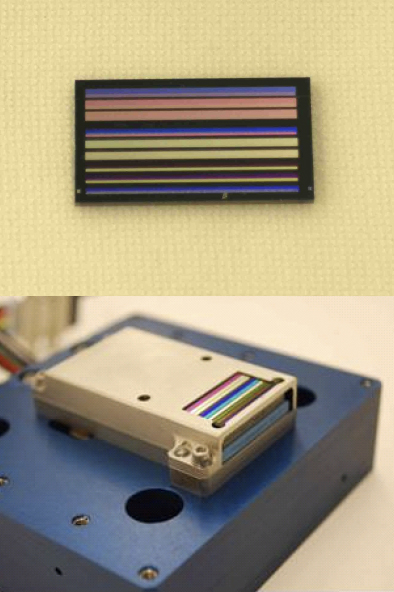By Laura E.P. Rocchio, Landsat Outreach Team
A paper published this month in the journal Remote Sensing chronicles the prelaunch, instrument-level spectral tests performed on the Landsat 9 Operational Land Imager 2 (OLI-2). Combined prelaunch testing results have been re-released in the paper—as well as on this website—as a continuous in-band and out-of-band relative spectral response (RSR) dataset.
OLI-2 is the first Landsat instrument to use the Goddard Laser for Absolute Measurement of Radiance (GLAMR) mobile facility for in-band spectral response testing. The resulting RSR measurements provide unprecedented detail for Landsat instrument characterization.
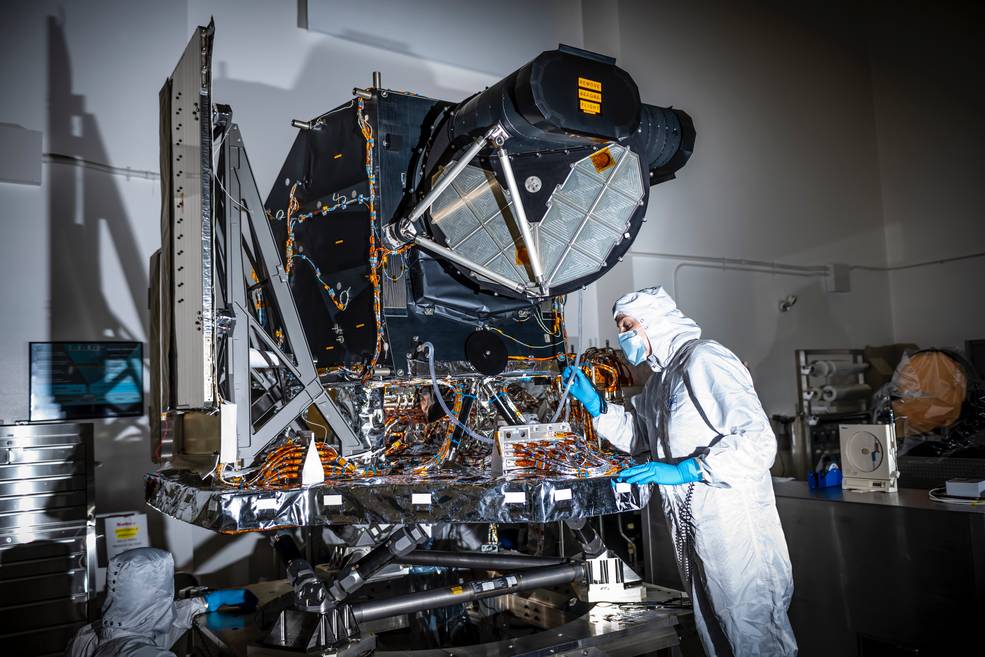
Getting to Know an Instrument
Landsat measurements are comparable over time and across sensors because of careful instrument calibration—a hallmark of the five-decade Landsat program. The high-quality calibration behind Landsat’s science-grade data takes deliberate, sustained effort that begins before a satellite’s sensor is even assembled.
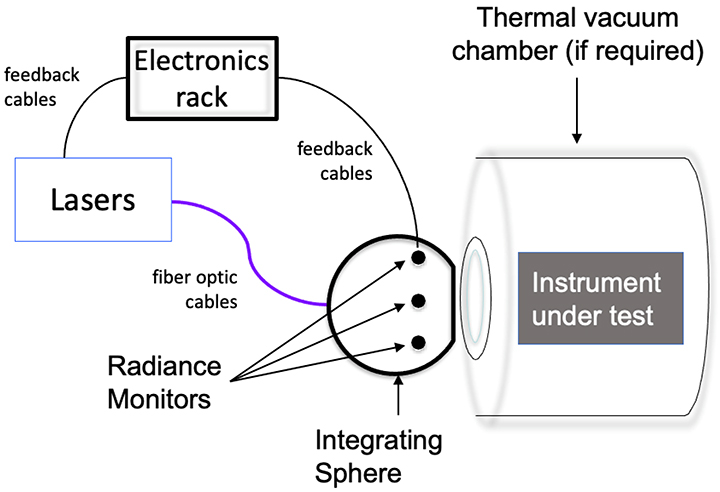
Prelaunch instrument spectral testing helps transfer international standards for radiometric calibration to an instrument as it is being characterized.
The characterization of an instrument’s ability to sense energy from the regions of the spectrum that it is designed to measure—the instrument’s relative spectral response (RSR)—is key to using its data.
You need the RSR to convert the quantized digital counts that a sensor records back into radiance; you need it for developing accurate algorithms that can relate the collected data back to physical properties of the ground target (like vegetation health and soil moisture); and you need it to corollate and compare data across different satellites and sensors.
A new laser-based method of instrument characterization has provided OLI-2 with the best spectral characterization of any Landsat instrument.
Lamps, Lasers, GLAMR
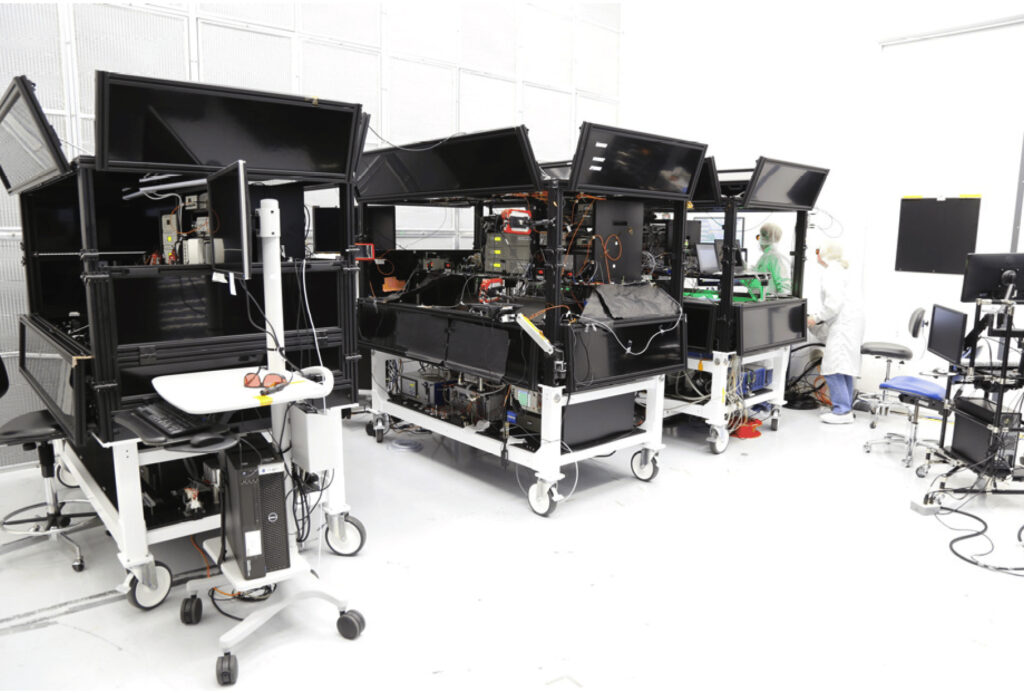
While Landsat 8’s Operational Land Imager (OLI) was spectrally tested using a lamp-based double monochromator system, OLI-2 was tested with the laser-based GLAMR system.
GLAMR is NASA Goddard’s mobile spectral test facility expressly developed for the spectral characterization and radiometric calibration of Earth remote sensing instruments. In addition to OLI-2, GLAMR has been used to characterize the VIIRS instruments for JPSS-2, -3, and -4, the airborne G-LiHT system, the Ocean Color Instrument aboard the recently launched PACE satellite, and the even the L’Ralph visible imager aboard the Lucy mission to Jupiter’s Trojan asteroids.
The GLAMR system consists of tunable lasers that are fiber connected to a 30” integrating sphere (picture a ping pong ball increased 20 times to the size of a giant yoga ball). The white-coated interior of the integrating sphere scatters the laser-produced light very efficiently, producing a uniform, flat light for the 300 to 2500 nm range of wavelengths that GLAMR can cover. The radiance exiting the integrating sphere is what illuminates the instrument.
(Calibration scientists like a flat light source because allows all the detectors in the instrument to see the same amount of energy at the same time; skiers meanwhile dislike flat light conditions because the diffuse, scattered light on cloudy days casts few shadows, reducing contrast, and making snowy slopes look deceivingly featureless).

GLAMR’s integrating sphere is constantly monitored by three NIST-traceable radiometers. Comparing the integrating sphere output to the instrument’s measurement of that output provides absolute spectral response calibration.
GLAMR made it possible to characterize every single OLI-2 detector. The instrument’s pushbroom focal plane is made of 14 focal plane modules each containing nearly 500 active imaging detectors for each of the 30-m bands (double that for the 15-m panchromatic band)—making a grand total of 69,160 detectors to test.
For the visible and near infrared OLI-2 bands, GLAMR tested the instrument spectral response in each band’s spectral region in 1 nm increments. For the wider shortwave infrared bands, 2 nm increments were used.
GLAMR found the OLI-2 spectral performance to be much better than required—it “beat spec.”
Up For the Job
Before OLI-2 testing with GLAMR could begin, the GLAMR team had to prove to Ball Aerospace, the instrument vendor, that it could safely and thoroughly test OLI-2. There was some concern that GLAMR’s powerful lasers could potentially damage the instrument.
The GLAMR team worked with Ball Aerospace to design experiments to demonstrate that its radiometric signals were stable over the test dwell time (the amount of time needed to bathe all 14 focal plane modules in the light), were sufficient to meet the instrument’s signal-to-noise requirements and, were modulated properly to avoid overwhelming (saturating) or damaging the OLI-2 detectors.
After those experiments, GLAMR was cleared to proceed with OLI-2 spectral testing.
Two Intense Weeks
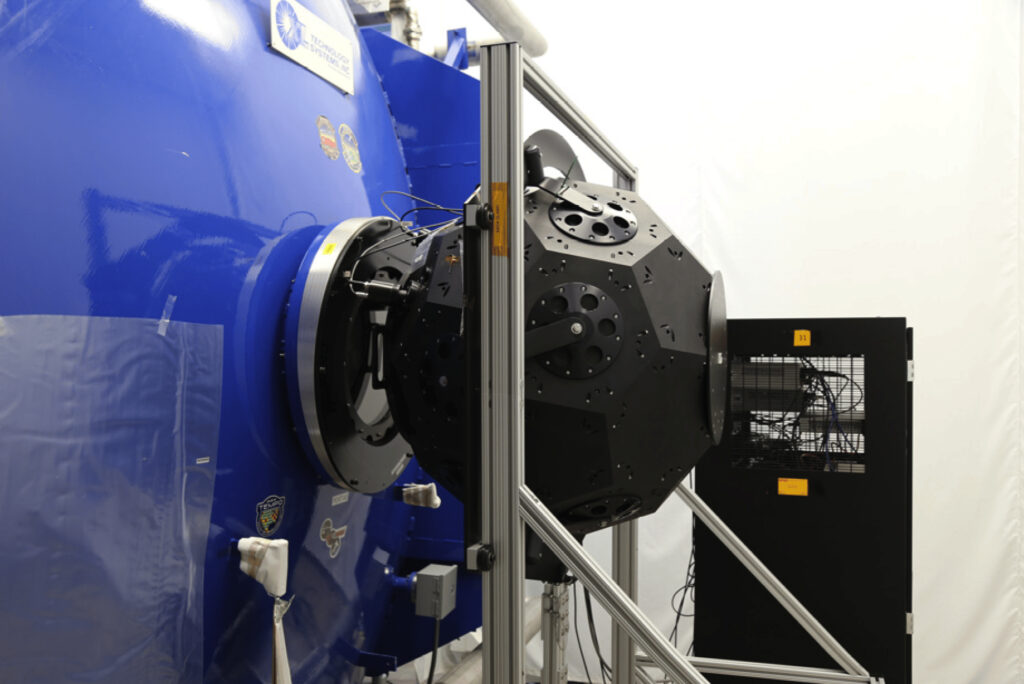
During 14 long days in November 2018, the GLAMR and Ball Aerospace teams worked through Thanksgiving to perform the instrument spectral test at the Ball Aerospace facility in Boulder, Co. Testing in a controlled environment ensured that OLI-2 was only measuring radiances from the calibration source (GLAMR’s integrating sphere).
The GLAMR team performed a check-out test of the GLAMR system as soon as they arrived. Once OLI-2 was placed into the thermal vacuum chamber (to emulate space-flight conditions) the exit port of the GLAMR integrating sphere was aligned with OLI-2 through the thermal vacuum chamber window (the GLAMR laser tables were in an adjacent room). OLI-2 then collected images of the GLAMR sphere illuminated at every wavelength.
Results showed that the spectral uniformity requirements were met by 99.2% of the OLI-2 detectors.
On the 7th focal plane module of the coastal aerosol band, the GLAMR team found that 170 detectors were out-of-spec as well as around 100 detectors on focal plane module 9 of the SWIR 1 band.
The teams established that this was likely due to small imperfections in filter sticks that could not be detected in previous spectral tests of the filters. Discovery of these imperfections has resulted in a more thorough understanding of the OLI-2 spectral response.
Fortunately, the impact of the filter stick imperfections on the science data is small and unlikely to affect most users.
Spectral Response of Record
The GLAMR-based RSRs derived for all 70,000 OLI-2 detectors during instrument-level thermal vacuum testing were used together to produce module-averaged in-band RSRs for all nine OLI-2 bands. This unprecedented level of detail is a major leap forward for Landsat calibration, providing scientists with a never-before-available amount of information that paves the way for unrivaled consistency in the Landsat data record going forward.
The best available measurements of out-of-band spectral response (i.e., how much energy outside of OLI-2’s bands can sneak through the spectral filters) were combined with the in-band RSRs to form the official OLI-2 relative spectral response—the spectral response of record.

Award Winning Character
For their work across agencies and missions, the GLAMR team was recently awarded one of the highest honors that NASA bestows: the 2023 Agency Honor Award for Group Achievement.
As the Landsat 9 OLI-2 RSR work shows, GLAMR has given prelaunch instrument spectral characterization a new level of specificity.
This post was updated on April 3, 2024.
Reference
Barsi, J.A.; Donley, E.; Goldman, M.; Kampe, T.; Markham, B.L.; McAndrew, B.; McCorkel, J.; Morland, E.; Pedelty, J.A.; Pharr, J.; et al. Prelaunch Spectral Characterization of the Operational Land Imager-2. Remote Sensing 2024, 16(6), 981; https://doi.org/10.3390/rs16060981

